
Volunteers restoring waterways

Canal Camp reports:
Wey & Arun Rooks Hill project gets under way
Lichfield Canal progress at Gallows Wharf





Canal Camp reports:
Wey & Arun Rooks Hill project gets under way
Lichfield Canal progress at Gallows Wharf


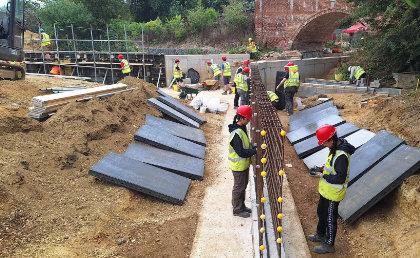
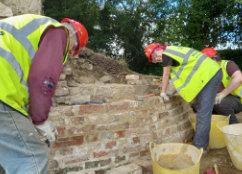
Rebuilding a lock wing wall, Louth Navigation
In this issue we’ve got camp reports from four Canal Camps on two different waterwaysbut our summer Camps programme included another four sites. We hope to bring you camp reports from all of them in the next issue; in the meantime these pictures provide a sneak preview of what our volunteers got up to at Weymoor, Louth and Neath…
Building a footbridge, Neath Canal
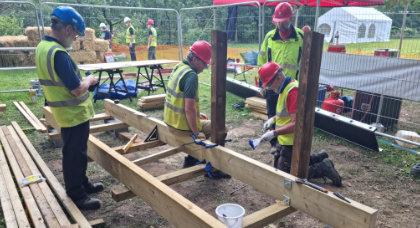
For latest news on our activities visit our website wrg.org.uk
See Facebook group: WRG
Editor’s Welcome and Letters Page 4-5
Chairman’s Comment and Reunion news6-7
Restorationfeature the new Rooks Hill project on the Wey & Arun Canal 8-11 CampReports Two weeks at Rooks Hill, plus the River Parrett 12-19 Diary Camps and working weekends 20-21 Camp reports Two weeks of channel construction on the Lichfield Canal 22-29 Nature&restoration Top 10 methods for nature-friendly canal restoraiton 30-32
Progress updates from around the waterways network 23-37 The German camp report translation! 38-39
PLEASE NOTE: subscriptions renewal cheques should be made out to The Inland Waterways Association. Note new address (right)
Follow us on @wrg_navvies
Editor: Martin Ludgate, 35 Silvester Road, East Dulwich London SE22 9PB. 020-8693 3266 martin.ludgate@wrg.org.uk
Contributions welcome, by email or post, to the address above. If sending a lot of large picture files, please contact the editor first. Pressdateforissue333:15September.
Subscriptions: Ayear'ssubscription(6issues) isaminimum of £5.00 (please add a donation if you can) to WRG, Unit 16B, First Floor, Chiltern Court, Asheridge Road, Chesham HP5 2PX. Cheques must be made out to The Inland Waterways Association (although the proceeds will be put to WRG / Navvies use).
Distribution: John Hawkins, 4 Links Way, Croxley Green WD3 3RQ 01923 448559 john.hawkins@wrg.org.uk
Navvies is published by Waterway Recovery Group and is available to all interested in promoting or supporting the restoration and conservation of inland waterways by voluntary effort in Great Britain. Articles may be reproduced in allied magazines provided that the source is acknowledged.
WRG may not agree with opinions expressed in this magazine, but encourages publication as a matter of interest. Nothing printed may be construed as policy or an official announcement unless so stated - otherwise WRG and IWA accept no liability for any matter in this magazine.
Waterway Recovery Group is part of The Inland Waterways Association, (registered office: Unit 16B, First Floor, Chiltern Court, Asheridge Road, Chesham HP5 2PX), a nonprofit distributing company limited by guarantee, registered in England no 612245, and registered as a charity no 212342. VAT registration no 342 0715 89.
Directors of WRG: Rick Barnes, George Eycott, Helen Gardner, John Hawkins, Dave Hearnden, Nigel Lee, Mike Palmer, George Rogers, Jonathan Smith, Harry Watts.
ISSN: 0953-6655
© 2025 WRG
Cover picture: The sun sets on the (very nearly) completed Cotswold Canals Weymoor Bridge project in this atmospheric shot by Steve Barrett. This summer’s Canal Camps finished the last section of the concrete canal channel construction over the stream culvert built alongside the rebuilt bridge. See picture opposite, and next issue for camp reports (please!) Back cover: Two views by Stephen Davis illustrate progress made on the Wey & Arun Canal’s new Rooks Hill work site: in the upper picture earthworks are just beginning at a pre-camps prep weekend; in the lower picture after two Canal Camps the bridge abutments are already up to the second stage
The editor welcomes new volunteers, worries a bit about the future, and begs for some more Canal Camp reports… situation normal, then!
A welcome from the editor to this issue of Navvies…
Navvies? What’s that all about? If you’ve just been on your first Waterway Recovery Group Canal Camp and you’ve unexpectedly found this magazine landing on your doorstep a few weeks later, you might be wondering what it’s all about. Well, this is WRG’s own magazine, and you’ve received a year’s free subscription, so you can read reports from all the Canal Camps, find out details of forthcoming Camps, learn about the mobile volunteer groups who go out working on weekend work parties on the canals all year round (and who welcome new volunteers), and find out about the wider world of waterway restoration.
Yes, but why’s it called Navvies? It takes its name from the original ‘navvies’ (short for ‘navigators’), the gangs of labourers who built the canals 200-plus years ago, and who travelled the country to wherever there was work to be done. Like them, we, the “21st century navvies” travel around the country to wherever we’re needed, supporting volunteer canal restoration projects across the country.
But back to those camp reports In this issue you can find reports from four camps on two projects – the Lichfield Canal and the Wey & Arun Canal – and I’m pleased to say that three of them have been written not by grumpy old WRGies like myself, but by first-timers, Duke of Edinburgh’s Award scheme participants and others from the next generation of canal restorers. And I’m equally pleased that we’ve also got a report from a more experienced volunteer, another piece from the point of view of the local branch of WRG’s parent body the Inland Waterways Association (who set up the project), and the usual interesting selection of progress reports from local canal societies and trusts. And a piece by a bunch of people who don’t restore canals, they restore boats…
Hang about, they restore boats? Yes, the Wooden Canal Boat Society, who labour away at the never-ending task of keeping an assortment of historic timber-built boats afloat (and not only that, but doing something useful – whether it’s running a recycling collection trip, providing wellbeing cruises, or whatever). And not only do we regard historic boat restoration as just as suitable content for the magazine as the restoration of disused waterways, but their report of a boating trip in this issue, just like their last one in issue 326, also raises an important point.
An eventful cruise They recently took a pair of boats onto the Huddersfield Narrow Canal, one of the most outstanding of completed canal restoration projects, reopened in 2001. This was the ‘impossible’ restoration, which turned what had been widely seen as a hopeless case (even by those within the restoration movement), blighted by urban and industrial development blocking the route, the partial or complete destruction of almost all of its 74 locks, numerous culverted bridges, and a collapsed three-mile tunnel, into a gloriously restored trans-Pennine route and a demonstration that “if the canal restoration movement can reopen this, then we can reopen anything”. But unfortunately their trip up the canal didn’t go smoothly. Two of the all-important ‘winding holes’ (turning points) for full-length boats had become silted and unusable, and they only managed to turn at a third one with a combination of a lot of brute force and ingenuity.
Sue Burchett R.I.P.
We are sorry to have to bring you the sad news that Sue Burchett, former WRG volunteer, cook, leading light of our WRG BITM regional mobile group and more, died on 25August. We will publish an appreciation in the next issue of Navvies.
Is the editor being churlish? You might think it sounds rather mean-minded of me to pick up on such a minor aspect of a magnificent restoration – and I agree, it does. However my point isn’t about the state of the winding holes in itself; it’s the response of waterways authority the Canal & River Trust to the WCBS’s letter of complaint. Basically they said “sorry but we can’t afford to fix them, in our current financial circumstances, as we need to spend our limited resources where they’re more effective.” And bear in mind that the forthcoming reductions in public funding for the waterways – from just over £50m to a little over £30m annually – don’t even start until 2027. What we see now is just the effect of inflation reducing the value of the current flat-rate grant.
The thin end of the wedge? So is allowing winding holes on the HNC to silt up simply a prudent decision to concentrate on the basics of keeping the actual canal open, to be applauded? Or is it the thin end of the wedge, to be resisted? And if the former, what further cutbacks can we countenance? I happened to be chatting with our Chairman Mike Palmer recently and we touched on the subject of lock gates. Would we tolerate CRT replacing hand-crafted wooden lock gates built by skilled specialists in traditional carpentry workshops with steel ones whose production might be subbed out to the cheapest metal fabricator, and which might last much longer? What are your thoughts on the matter?
Dragging the discussion back on-topic and looking at a couple of other things that Mike and I also discussed in passing – the many already life-expired timber lock gates on the Neath Canal which will need replacing if the restoration is to progress; and the amount of this summer’s Canal Camps programme that seems to have involved modern reinforced concrete civil engineering work – might we find the restoration movement increasingly facing similar decisions, given the difficulty in securing funding for future maintenance? Once again, feel free to send your thoughts on this to the editor.
And finally (1) the mention of these projects brings us back to Canal Camps. Please can we have some camp reports from the rest of the Camps for the next issue? Many thanks.
And finally (2) apologies for the late arrival of this issue. Normal service will (we hope) be resumed with the next issue.
Martin Ludgate
Dear Martin
An email from an old WRGie about Mike Palmer’s comments about CRT and their attitude. I have been on canals since the age of five (I’m now 60!) and did quite a bit of restoration work in the early 1980s - unfortunately life has not allowed me to get back into it at the moment, but I did do a couple of sessions at Foxton three years ago. It was no surprise to me that the lock keeper there frowned when I told him I had done work with WRG, and tasks I was given were sticking plasters rather than doing a proper job. It was shocking to see the condition of much of the brickwork which had obviously been redone in the not-too-distant past and which was falling apart. He seemed more interested in how they could use the site to generate more income and was moaningabout the lack of money for work.
The ‘us and them’ attitude seems entrenched - I seem to recall threats of staff of the former British Waterways Board striking over the thought of volunteersdoing ‘their’ job in years gone by, when in reality they often were making a brew when we went past rather than actually doing anything. I think a few heads need knocking together!
Kind regards
John Stroud
PS I often think of past days. Was VRK one of the old vans? I just remembersitting in the back on a still hot generator watching the road go by through a hole in the floor and the clutch replaced with a length of baler twine in another van. Ah, the good old days! The editor replies: yes, VRK was one of them. My own memories are of similarly rusty PFD.
“Itisthankstothecontributionyouallmakethatwordsoffun/enthusiasm / success / rewards tumble through every sentence in these pages”
The edition of Navvies that comes out immediately after the summer Canal Camps have finished is usually one of the easier ones for me to contribute to. (In other words my Comment is only a day or two behind Martin’s deadline as opposed to several weeks!) Because usually Martin is still chasing people for the reports from those Camps, and so I am free to report back on all the general success of the summer, with perhaps the occasional reference to fun and laughter I have heard about through the “towpath telegraph”.
However, this year it seems that 50 percent of our summer Camps have already generated reports for you to read in these very pages (and I’ve seen at least one further report that has been received but didn’t make it into this edition). In itself, that is a fact worth celebrating; however there is another detail that I’d like to highlight here: five out of six of the Camp reporters are young people new* to WRG.
Now I’m not attempting to start any discussion about the value (or not) of years (because let’s face it someone could be sixty but brand new to WRG, or twenty and have
several camps under their belt). I’m just pointing out that WRG is still attracting young people to our activities and the evidence would seem to suggest that they are finding it so enjoyable and rewarding that they are prepared to (punctually) write about it. Which is something I have always been rather proud of – our publicity states that “age doesn’t matter, nor does previous experience” and for many decades I have seen that in action. It’s certainly not unusual at the end of a Camp for (say) an eighteenyear-old to be hugging and thanking a sixtyyear-old for the hilarious fun and rewarding experiences they have had on their Camp and vice versa. Now of course all of this does take some effort - over the years we have all worked hard to ensure that the Canal Camps ‘brand’ really does stand for something: things like levels of planning, quality of work, safety, work, numbers, bookings, catering, accommodation, that sort of thing. My thanks to everyone who sticks to these (sometimes unspoken) rules and please enjoy these Camp reports – it is thanks to the contribution you all make that words of fun / enthusiasm / success / rewards tumble through every sentence in these pages.
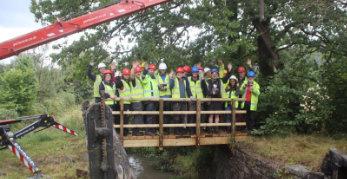
more pictures of work that we’ll be reporting on in the next issue: the
Given you all have proper Camp reports to read, what extras can I mention from my summer?
The first is undoubtedly a positive – this summer we included a copy of WRG’s parent body the Inland Waterways Association’s Waterways for Today report in the flightcases on each Camp. By all accounts it was read and appreciated by lots of people. Appreciated not just for the facts and arguments it contained but also appreciated as readers could see that the contribution they were making was part of a much bigger campaign.
The second is the shocking news of the passing of Sue Burchett. As explained on page 4 there will be an appreciation of Sue
in the next edition. However, a quick search through my text above reveals two main themes – ‘making a contribution’ and ‘fun’. Her contribution was huge (is there anybody reading this who has not been fed by Sue?) but everybody remembers the fun that was had along the way. Our thoughts and love are with Roger and family.
Mike Palmer
* OK - so the Schimansky contingent do have a proud and impressive WRG heritage through their father, but they still count as two of our younger/newer volunteers.
PS – Lovely to hear from you John Stroud (letter on page 5) – all the best.
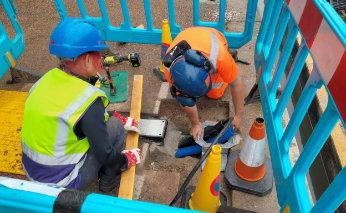

This edition of Navvies includes reports from NWPG and KESCRG on two very enjoyable and productive summer camps at Rooks Hill Farm on the Wey & Arun Canal. I thought that readers might be interested to know a bit more about how the project came about and the work necessary to get the project up and running before the first camp on 5th July.
Rooks Hill is towards the northern end of the canal, south of Bramley village. The area of work forms a southern extension to a 900 metre length at Birtley which was restored between 2019 and 2023. This included two new lifting bridges, one of which was built with the support of WRG camps. Having established an attractive in-water section of canal together with a (now) very popular circular footpath, it was natural that the Wey & Arun Canal Trust would want to extend the length south.
This next section would be a big project with a number of new structures required. 300m of the canal had been infilled sometime in the 20th century and turned into a farm track. A former swing bridge was now a causeway and would need replacing with a new bridge, a culvert needed repairing and extending, and the site of a lock was only identifiable by a slight rise in ground levels. The good news was that the landowners were prepared to sell or donate about 600m of canal route; the Trust has taken possession of this.
However this was only the start of a four and a half year journey to secure the necessary permissions before work could start. These included planning permission (and all the associated flood zone issues, ecological surveys and mitigations), design consent for the new bridleway overbridge, construction access approval, land drainage consent (for the culvert works), tree protection and planting proposals. Then, having gained planning permission in February 2025, there were six pre-commencement planning conditions to deal with. Most of this work was done by the WACT project team with paid consultants providing advice/reports on tree matters and ecology.
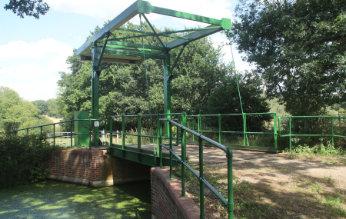
The Rooks
length will link up with the restored Birtley section with its two lift bridges
Canal’s Rooks Bridge site, we take a look at what this new project involves…
So, from receiving planning permission in February 2025 to the first NWPG/WRG camp there was just over four months to get everything in place – not a long time given what had to be done.
Our first job was to erect about 250 metres of tree protection fencing comprising Heras fence panels reinforced and anchored into the ground with scaffolding. A 3 day NWPG dig in March made a good start on this (and the site compound) with the local team completing the work in time to get sign off from the Council’s tree officer. Next task was to finish the compound set up – welfare unit, fuel cube, fencing and gates – together with the removal and re-positioning of fences and gates to provide a vehicle turning area.
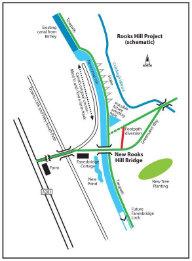
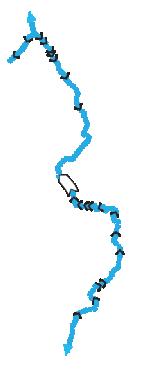
The second task was to sort out the construction access. Although at Rooks Hill there is a direct route from the A281 to the site compound, it crosses over the Downslink Path (a former railway, now a cycleway) before reaching the canal. The landowner, as part of the sale agreement to the Trust, had imposed a 3-ton limit on the bridge. This would prevent concrete and other deliveries to the site and thus involve the need to build in a construction access from the south – a long job in both time and cost.
Here the length of time gaining planning permission was to the Trust’s benefit as the landowner passed away and the farm went to his daughter, who had no wish to enforce the self-imposed weight limit on the bridge. The risk was one for the Trust. Trial pits were dug and calculations made, with the engineers concluding that with some additional surfacing over the arch top, 40 ton lorries could cross the bridge. Without this, the Canal Camps would have had to spend their two weeks building a temporary access road rather than getting on with the actual construction work.
And so to the camps themselves - and to provide some context to the work proposed, I need to briefly explain the project plan phasing:
Phase 1 Comprises a new bridleway overbridge, repair and extension of a land drain / stream culvert under the canal and the construction of a waterway wall on the east bank of the partially re-routed canal. This was the work for the 2025 camps and other working parties – all three tasks to be taken on simultaneously to ensure camp volunteers would be fully employed.
Phase 2 Excavation and bank work of 300m of new canal to replace the infilled channel north of the new bridge (built during phase 1) to link with the restored Birtley section. Works to west bank south of bridge. More information on this later in the year. Possibly a project for WRG camps in 2026?
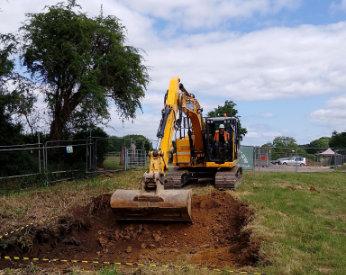
Start of excavation on the Rooks Hill bridge site on 16 June…
Phase 3 Construction of new lock. Timing to be determined.
The plan for the NWPG and KESCRG camps was to progress the phase 1 works with the main target being to construct the concrete bridge abutment walls to full height by the end of the two weeks. This meant that by 5th July the bridge hole had to be dug out and a concrete base cast. This required a 13 ton excavator, 2 x 9 ton dumpers and, starting on 16th June, 7 days of almost continuous work by volunteers from KESCRG, NWPG, WRG and WACT. The work extended south from the bridge to incorporate the re-alignment of the canal from its original route. Local WACT volunteers then completed the setting out of the position of the proposed new bridge abutments before casting the base. This work was completed one week before the start of the NWPG camp.
I have not detailed many of the other tasks necessary for the camps to function effectively - such as the preparation of risk assessments and method statements, assembling the materials, ensuring the finance is in place and so on. These are all rather uninteresting but essential before any work starts on the ground. I hope, however, that I have provided an insight into the amount of preparatory work that can be required to run an effective camp on a major construction project. Nevertheless, the effort was well worth it as the contribution made by the NWPG and KESCRG / WRG camps well exceeded my expectations – as you will read in the separate camp reports. Just one month from the first digger bucket in the ground to a bridge ready for its arch to be cast – plus all the other jobs. Since the camps, work is now well underway on the bridge wing walls and on completing the headwall of the culvert. One projection I’ve seen shows the bridge, culvert, weir and east bank waterway walls being completed by the end of the year. Not impossible if the weather stays dry and we continue to receive the fantastic support from the volunteer teams - both local and visiting groups.
Bill Nicholson (with my Wey & Arun hat on!)
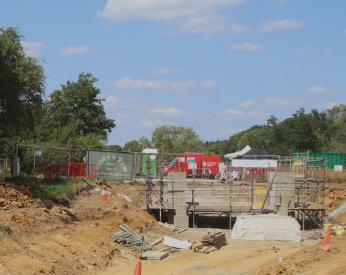
…and the same scene at the end of the second camp with the bridge abutments in place
Reporting from the first of two rather warm weeks at Rooks Bridge: work starts on the new bridge abutments, and the culvert extension
Wey & Arun Canal Camp report NWPG and friends at Rooks Hill, 5 - 12 July
The first week of the Wey & Arun canal camp started at a pleasant temperature, and even with a splash of rain, which did not last for long. Soon enough the third heatwave of the year took a grip and gave us beautiful clear skies and sunshine but scorching temperatures of 30C.
Our work focused on the start of constructing a bridge and repairing one end of a culvert under the canal at Rooks Hill Farm. About 2 metres of wooden boardings were put up ready for concrete pumping on Wednesday afternoon. A concrete base was also created for the culvert for the stream with lots of digging required! The bottom of the hole had to be filled with rubble which had to be carefully spread many times by hand. Concrete blocks and mesh were added on top before the concrete was poured into the wooden frame surrounding everything. The framing for the base of the bridge was speedily erected so it was ready for the concrete on Wednesday afternoon. Taking all the boards down as well as tidying up the site was a difficult task in the sweltering heat at the end of the week.
Our evening meals were always a moment that was sought after as we knew the food would be delicious. My favourite was the final meal: Roast Pork with all the trimmings! Other evening activities included skittles which became competitive quickly and swimming at Guildford Lido, a refreshing trip!
We had lots of fun (but lots of anxiety) on Friday as we had the BBC coming to film us for Morning Live to promote working holidays. Our breakfast and work were caught on camera as well as interviews with those brave enough to put themselves forward. As the youngest I was automatically guaranteed to be interviewed, but I was happy to take part! I hope it will encourage more young people to try out an experience like this!
Look out for our snippet on Morning Live that will be on air in September!
Grace Rudler
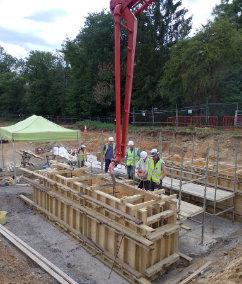
Pouring the first stage of the east side bridge abutment
Postscript: My thanks to Grace and all those regulars and newbies who came on the camp and worked so hard. The weather was, as is now becoming usual for early July on the W & A, very hot at times. I can’t really complain as it would have a nightmare site if it had been a wet week. The amount of work completed over the two weeks (NWPG & KESCRG) was incredible such that Nigel Yarwood, the project engineer suggested that HS2 could usefully use our services! The photos of the first “sod” being cut on 16th June and that for the end of the KESCRG camp show just what can be achieved in a month.
Bill Nicholson

Length: 23 miles Locks: originally 26 Date closed: 1871
The Canal Camp project: The first stages of building a bridge at Rooks Hill, plus reinstating a section of canal channel and extending a stream culvert under the canal
Why? The bridge will carry the Downs Link bridleway over the canal, allowing the removal of an existing causeway and clearing the way for reinstatement of a length of canal which will also include the rebuilt Fanesbridge Lock.
Restored Summit length Canal Camp site: Rooks Hill Birtley lift bridges section Ready to pour the concrete base for the culvert extension and exit chamberr
The wider picture: Excavation of a 300 metre length of canal (where the original channel has been filled in) will link the Rooks Hill length to the Birtley section which has already been restored in recent years including building two new lift bridges, creating a longer length of restored canal. For the longer term, the work here reduces the amount of unrestored waterway between the restored summit section at Dunsfold and the north end of the canal. In the coming years it is hoped to link the restored sections together to create longer navigable lengths, with the eventual aim of reopening the entire through route between the Thames and the South Coast.
Restored Loxwood Link section

KESCRG take up the reins for week two: continuing the bridge abutment and culvert work, as well as creating the new canal channel
Wey & Arun Canal Camp Report Week 2, led by KESCRG: 12 - 19 July
Following on from the first week, Lucy and Alicia - two of “The best ever DofEers” (Duke of Edinburgh’s Award young volunteers) in the words of leader Stephen - report from the second week, led by mobile working party group KESCRG. Here’s Lucy to start off…
On our first day, we established a rule: “What happens on Canal Camp, stays on Canal Camp”. So, when we were sat in the pub (on one of the many occasions we ended up there) and our Camp Leader, Stephen, dropped that we’d need a report on our week’s shenanigans, Lucy – that’s me – and Alicia jumped at the chance to break the rule (a decision made with no alcoholic encouragement).
The main event of the Camp, in my (Lucy’s) humble opinion, was the concrete pour for the bridge being built at Rooks Hill. Our team started the week by cleaning up the shuttering used on the first pour on the previous week’s Camp (see report on previous pages) and cutting those that needed changing to size. Mick showed off his amazing pocketknife-pencilsharpening skills as we marked out the level of the pour and we got started moving the shuttering forms up the scaffolding.
Now, as we started putting the shuttering into place, an interesting problem started to emerge. We had very little plastic piping for protecting the DYWIDAG bars (as William insisted that they be called), and so I was called upon to climb INSIDE the shuttering and fashion bespoke piping for each bar so they could still be pulled out afterwards. Young knees get all the contortionist jobs! From inside the shuttering, the main challenge – apart from weaving between the threaded bars like lasers in a spy film – became getting people to pass me things, as I am very short and apparently not very loud. There were only a couple of jokes about leaving me inside overnight or to be slowly trapped within the concrete pour. Not threatening at all! Eventually, I’d given all the pipes their tailored jackets but was not yet free from my “coffin”, as we were still missing the mould release.
Very soon, all the other teams had finished and were waiting impatiently to get home

Shuttering up ready for the second stage concrete pour on the bridge abutments
to Anne’s cooking, so we all ended up elbow-to-elbow inside, finally finishing far too late but ready for the pour in the morning and ravenous for cottage pie. Wednesday dawned early with an even earlier start to the pour, the concrete pokers (which have no other names and caused no giggles) were powered up and us DofEers were far away from the two 7.8 cubic metre concrete pours. Stephen, Dave, and many other far more talented workers were in charge of making sure it was all ready to go and setting correctly. More exciting was the grand reveal on Thursday, as the shuttering came away to reveal the brand-new second layer to the bridge! It got many oohs and aahs and a fresh coat of black bituminous paint to protect against water damage and chemicals in the soil. Naturally, I ended up back at the shuttering for that last paint job, getting very sticky, protective black paint dripped on me by Molly and Oliver (which I’m still trying to scrub off even now). For those curious, I wouldn’t recommend painting something black on a day with highs of 30 degrees! It was a very toasty job. The bridge, as it stands, now looks amazing! I look forward to seeing what the next group of volunteers does.
I,Alicia, personally worked on The Culvert, which had been there for significantly longer than Queen Elizabeth’s reign.Admittedly, we did spend the majority of the first morning on site standing over the floor plan trying to decode it as though it were Egyptian hieroglyphics, which eventually came to a successful conclusion. We realised that the concrete slab was not the shape nor size that was expressed in the diagram, so we had to do a bit of adjusting which involved demolishing one unlucky sharpie in order to get our measurements right.
Placing blocks on the ground in the astounding heat was hard work, but soon enough we found ourselves in the precarious position where the wall was getting high enough to need a step, which was no easy feat, but it did feel like some sort of achievement. Of course, not everything went smoothly; the optimum way to fit a pipe was discussed at length until it was eventually decided to slot it on, which turned out well enough.
There may have also been a few other flaws along the way such as me laying an entire course a centimetre too high, having to rip it up and redo it all within the space of two chaotic hours… but of course the only suitable solution was to blame it on the bricklayer before me. (Cough cough, Ian….)
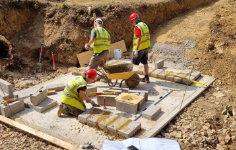
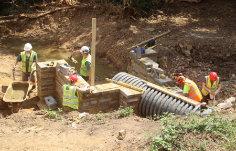
Eventually, the last block was placed on the last day, and it felt very rewarding. We managed a lot in such a small amount of time, and considering this was my first time block laying, I …and the structure nearing completion on the final day

think most of the credit goes to Ian and Alan, with special thanks to Steve, Ceri, and John for cutting our blocks for us. And the mixing team, for the most part (kidding) did an amazing job as well. Of course, Mick deserves his own special mention for his work on the pipe, which was truly remarkable. His supports kept the culvert from collapsing in on itself, which as I am sure you can imagine is quite an important job. He eventually got his turn to climb up the pipe, along with a few people who followed suit afterwards, to celebrate its stability. Overall, it was due to lots of people’s collaborative and amazing hard work that allowed for the completion of the build.
Back to Lucy for news of a couple of other tasks…
Now, as you may establish from how detailed – and enthusiastic – we were about the other two jobs on site, neither Alicia nor I started the week with the canal bank crew. Their job was to divert the course of the canal from what it had been, and dig down to lay the concrete foundation for the bank alongside where the canal will eventually flow. Of course, this meant that the MVP of this squad was Adrian and his masterful digger work.
Molly and Oliver, the other 2 of our 4 DofE volunteers, were on this team the first days on site. Maybe they’d tell you differently if they were here to defend themselves... but they’re not, so I can confidently say they spent their time lounging in the shade away from the harsh sun rays, every so often hopping out with the fancy level to tell Adrian whether he was 10mm off. Adrian, however, lived up to his nickname of “Velcro”, working hard, permanently attached to the digger seat, and almost forgetting to join us for tea breaks!
By the time the concrete arrived on Wednesday, the foundation was level and long, with much of it past the expected goal being ready. Stephen and Ed then took it in turns in the wellies, levelling out the concrete and trying not to fall face first into it, while Molly and Oliver finally earned their biscuits with much concrete shovelling and clear banksman signalling to the dumper truck drivers. The scaffolding Alicia and I made for the foundation that day held up perfectly, thank you very much, and – apart from someone getting stuck in the wellies – the day went swimmingly.
Naturally, Adrian’s digging didn’t stop with the concrete pour! The last two days on site were a challenge to see just how far he could push it for the next volunteers to just have to fill it in. It’s here I got properly involved.
Alan, whom I shall introduce as having mainly worked on the block laying throughout the week and who drank each evening from a silver goblet, gave me dumper truck training so that I could get my ticket and join Adrian in emptying out the future foundation. It was amazingly fun and taught me that more vehicles should be articulated; it makes it so much easier to parallel park! With Alan signing off as my instructor and Adrian’s approval on my direction-following skills, we made good headway.
Of dumper trucks, I learnt 3 important facts (aside from my actual training, of course):
• The seats are black and that means every time you sit on it in 28 degree weather you will boil from the seat of your pants up;
• When going up a hill it sometimes feels like trying to stay in the saddle of a rather cantankerous horse, and finally…
• You can see so little of what you’re carrying that, without a banksman, unloading feels more like spiritual communication, accessing your third eye to feel that all the dirt is out.
Friday ended with Adrian expertly swinging the digger to get as much shifted as possible, leaving the next group with a perfectly level foundation to fill in beyond what was achieved by Wednesday. All the different teams on site played an important role in how far we got, and, despite my joking, everyone pulled more than their own weight in making sure we managed it.
Now that we’ve covered all the “boring” bits, it would be remiss of us to forget the most important person of our team this week: Anne! Singlehandedly, she provided the food for us all over the course of the week, with the most delicious dinners and best sandwiches. The most notable work was a mouthwatering banana cake which was so good everyone was after seconds (and thirds... and fourths). Her food is the reason most people got through the week, as well as her being an absolute amazing person to have around.
We kept ourselves entertained in the evenings with prescheduled activities which were a great laugh. On the first night, we went out to the pub to socialise and get to know each other, which was a lovely way to ease into the experience, especially for us newcomers. Another night, we went out and played skittles where there was a strong level of competition between both teams, which Stephen decided would be named after the vans we arrived in, RFB and EHP. Of course, RFB won (which was mine and Lucy’s team) –needless to say, the other team did not stand a chance. Oliver on the RFB team was a notable heavy-hitter, and Ceri of EHP fame scored a last-minute spare which was thoroughly impressive, but as the night wore on everyone’s performances got decidedly worse, in linear correlation to alcohol consumption.
Another night saw us on a walk past a previous restoration site that finished in 2018 and naturally ended up at the pub afterwards. The next night also saw an impromptu pub visit, which at that point was basically a second home to us all. Oliver played the especially significant role as a canvas on one of the later evenings and ended up with a remarkably interesting sleeve of pen ink tattoos, which he modelled like a professional.
All in all, the evening activities were made by the company we brought with us. The easy-going and lively atmosphere which followed us from skittles and pub nights to site the next day was pivotal in the week being as much of a success as it was.
DofEers Alicia and Lucy
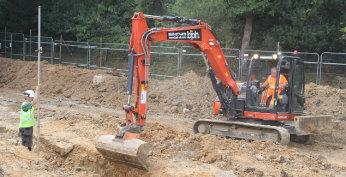
WRG spent a week-and-a-bit over Easter supporting a local IWA and local authority project for Somerset’s River Parrett. IWA reports back…
We included a Camp Report from the first WRG camp on the River Parrett in issue 231, but we have now also received the following report and pictures (originally for Waterways, the magazine of WRG’s parent body the Inland Waterways Association) written by Sandy Wright of IWA West Country Branch, which looks at the work from a different angle…
The busy riverside in Langport, Somerset, was the focus for the first Waterway Recovery Group Canal Camp of 2025.
An historic market town along the River Parrett, Langport has become a popular destination for locals and visitors thanks to its river regeneration project, completed in 2020. In fact, it has become so popular that its riverside paths were already worn down.
WRG’s brief was to upgrade and improve the network of paths that run alongside a half-mile section of river from Bow Bridge to Huish Bridge, including Cocklemoor, an open meadow between town and river. A group of ten WRG volunteers attended for a ten day camp across the Easter weekend.
With their mini digger, dumper and roller, plus barrows and hand tools, the team widened and relaid the paths using a combination of original and new path materials. Unfortunately, they ran out of time to complete a section of the Bow Bridge end. Gerard Tucker, Langport’s Town Clerk,
helped to organise setting up the camp. He commented: “We estimate the paths are used by approximately 240,000 people per year, which means they are subject to a lot of wear and tear. They needed resurfacing and making wider so that people are less likely to walk on the grass. WRG had helped previously with our project - removing silt from a slipway and clearing trees - so we asked IWA whether they could help again.
“Since WRG’s latest visit, the comments from those using the paths show the importance of what has been achieved. Locals are full of praise for the outstanding work the team undertook on our behalf. We are in awe of the fact that so many people are prepared to give both their time and skills to support communities many miles from home.”
WRG Team Leader David ‘Evvo’ Evans said: “The team enjoyed their time inLangportvery much. Working in the centre of town is an unusual location for us. It was amazing to see so many people enjoying Cocklemoor and the River Parrett. The many compliments we received from walkers were much appreciated, as were the excellent cakes and biscuits we received daily!”
Sandy Wright
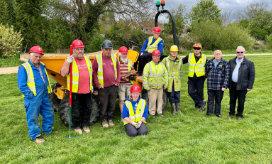
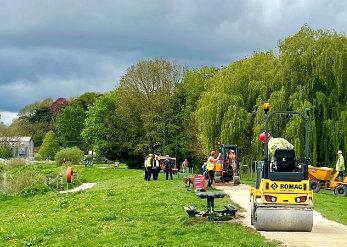
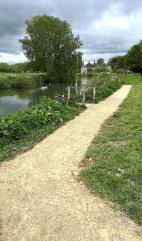

Week-longCanalCampscost£80orasstated.Bookingforeventslabelled‘WRGCanal AsheridgeRoad,CheshamHP52PX.Tel:01494783453,enquiries@wrg.org.uk.Diary
Sep6-7
London WRG
Sep6-7 KESCRG
Sep20-21 wrgBITM
Sep20-21 MBBCS
Sep 28Sun WRG
CotwoldCanals(eastern):WeymoorBridge.JointweekendwithKESCRG
CotwoldCanals(eastern):WeymoorBridge.JointweekendwithLondonWRG
MaidenheadWaterways:BrayCut
Manchester,Bolton&BuryCanal:NobEndLocks
WRGCommittee/BoardMeeting:RowingtonVillageHall.NotedatechangedfromSat
Oct4-5 London WRG Shrewsbury&NewportCanals
Oct4-5 KESCRG Tobearranged:Wilts&BerksatPewsham?
Oct5Sun NCA
Oct 17-19 NWPG
Oct18-19 wrgBITM
Oct18-19 MBBCS
Nov15-16 wrgBITM
Nov15-16 MBBCS
Nov22-23 WRG
NorthernCanalsAssociation:MeetingonShrewsbury&NewportCanals
Wey&ArunCanal,RooksHill
BasingstokeCanal:Offsiderhododendronclearance
Manchester,Bolton&BuryCanal:NobEndLocks
MaidenheadWaterways:BrayCut
Manchester,Bolton&BuryCanal:NobEndLocks
PossibleWRGReunion:tobeconfirmedinnextissue,seealsopage7
Nov22-23 NWPG Tobearranged
Dec6-7 London WRG
Wey&ArunCanal.JointChristmasdigwithKESCRGandWRGForestry
Dec6-7 KESCRG Wey&ArunCanal.JointChristmasdigwithLondonWRGandWRGForestry
Dec6-7 WRG Forestry Wey&ArunCanal.JointChristmasdigwithLondonWRGandKESCRG
Dec13-14 wrgBITM Tobearranged:XmasWorkParty
Dec20-21 MBBCS Manchester,Bolton&BuryCanal:NobEndLocks
Dec26-Jan1 WRG Christmas/NewYearCanalCamp,detailstobeannounced
Mar14-152026 IWA/BCNS/WRG BCNCleanup:likelytobeonnorthernpartofBCN,possiblyDawEnd/Rushall
Mar222026 NCA
NorthernCanalsAssociation:MeetingonChesterfieldCanal
CanalCamp’ shouldgoto:WRGCanalCamps,Unit16B,FirstFloor,ChilternCourt, contributionstoDaveWedd,Tel07816175454,dave.wedd@wrgbitm.org.uk
Tim Lewis 07802-518094 london@wrg.org.uk
Ed Walker 07887-568029 ed@edwalker.org.uk
Dave Wedd 07816-175454 dave.wedd@wrgbitm.org.uk
Sam Kennion 07843-394161 samklancs@yahoo.com
Sat27September 01494-783453 enquiries@wrg.org.uk
Tim Lewis 07802-518094 london@wrg.org.uk
Ed Walker 07887-568029 ed@edwalker.org.uk
Ivan Cane northern.canals2021@btinternet.com
Bill Nicholson 01844-343369 bill.nicholson@weyarun.org
Dave Wedd 07816-175454 dave.wedd@wrgbitm.org.uk
Sam Kennion 07843-394161 samklancs@yahoo.com
Dave Wedd 07816-175454 dave.wedd@wrgbitm.org.uk
Sam Kennion 07843-394161 samklancs@yahoo.com
Bill Nicholson 01844-343369 bill.nicholson@weyarun.org
Tim Lewis 07802-518094 london@wrg.org.uk
Ed Walker 07887-568029 ed@edwalker.org.uk
Ed Walker 07887-568029 ed@edwalker.org.uk
Dave Wedd 07816-175454 dave.wedd@wrgbitm.org.uk
Sam Kennion 07843-394161 samklancs@yahoo.com 01494783453 enquiries@wrg.org.uk
Ivan Cane northern.canals2021@btinternet.com
How’s your German? Can you make sense of this report from a week’s work on creating the new canal channel by Gallows Wharf?
Lichfield Canal Camp report: Week 1: 26 July - 2 August at Gallows Wharf
As requested by the camp leader Colin Hobbs the camp report for this year’s first week at Lichfield will be written completely in German.
Editor’s note: for those whose command of German isn’t quite up to reading this, you can turn to page 38 for an English translation, or to page 27 for a rather more conventional report from Week 2
Das WRG Camp vom 26.07.2025 biy zum 02.08.2025 stellte die erste von zwei Wochen an der Lichfield einsatzstelle.
Length: 7 miles Locks: 30
Date closed: 1954
The Canal Camp project: Building sections of reinforced concrete canal channel near Gallows Wharf
Why? It’s part of a project (which also involves Lichfield & Hatherton Canals Restoration Trust building a new lock, and the local authority building a new road bridge) to link together two already completed sections of canal at Borrowcop Locks (Tamworth Road) and Gallows Wharf, on the outskirts of Lichfield.
Am Samstag sollten alle Teilnehmer bis spätestens 14:00 Uhr an der Unterkunft eintreffen um dann anschließend die Arbeitsstelle besichtigen zu können. Für diejenigen, die eher da waren hieß es erstmal anhänger ausladen, Invantar kontollieren und alles wieder in den Anhänger und die Bullis eingepackt. Während dieser Zeit wurde auch mindestens ein neuer Spitzname vergeben. HuddlesfordJunction CoventryCanal ToFradley
The wider picture: The work is part of a long-term plan to connect various sections of new and restored canal together to create a restored route running through from the Coventry Canal at Huddlesford Junction to Lichfield, and beyond to link up to the navigable length of the Wyrley & Essington Canal at Ogley Junction. This would not only create an attractive restored waterway in its own right, it would also provide a route to encourage more boats onto the navigable but underused northern reaches of the Birmingham Canal Navigations network.
underrailway
Newdeeplock 8planned
CanalPark) Newstaircase locksplanned Canaldiversion underconstruction
The Lichfield Canal is the name given by canal restorers to the disused 7 miles and 30 locks from Ogley to Huddlesford which formed the eastern end of theWyrley & Essington Canal, part of the Birmingham Canal Navigations.
Da einige Personen sich verpäteten sind wir erst gegen 14:30Uhr tatsächlich in den zwei neunsitzer Bullis losgefahren um unseren Einsatzort erstmals zu besichtigen. Auf dem Weg kam uns der letzte Nachzügler entgegen, der sich aber dazu entschied zur Unterkunft zu fahren und erst am folgenden Tag das erste mal auf Gelände zu kommen. Nachdem wir uns die Einsatzstelle hatten Zeigen assen ging es zurück zur Unterkunft wo es dann eine Sicherheitseinweisung gab, die vor allem darauf bedacht war welche Schutmaßnahmen wir zu jeder Zeit tragen sollten und das wir auch einander dran erinnern sollten sich sicher und ordentlich zu verhalten, denn nur eine ordentliche Arbeitstelle ist auch eine sichere Arbeitstelle.
Nachdem also alles an Sicherheitsbelehrungen endlich abgeschlossen war hatten wir vor dem Abendessen noch freie Zeit zur verfügung. In dieser Zeit haben einige ihre Schlafplätze aufgebaut während andere ihr Persönliche Schutzausrüstung zusammengestellt haben.
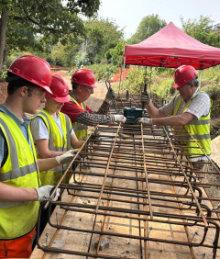
First, mesh is cut and the reinforcement ‘cage’ for the base assembled
Beim Abendessen gab es dann einiges an unterhaltungen, wobei es auch eine Diskussion darüber gab, weshalb Jack jetzt den Spitznamen Ginger hat. (Er trug ein Orangenes T-shirt). Nach dem Essen war es jedem selbst überlassen ob er schon schlafen gehen würde oder noch zu Gesprächen und Spielen im Gemeinschaftsraum bleiben würde. Sobald die ersten sich in den Schlafraum begeben hatten, hieß es dann, dass diejenigen die sich im Aufenthaltsraum aufhielten nun viel leiser sein mussten damit die anderen schlafen konnten.
Am Sonntag ging es dann nach einem guten gemeinsammen Frühstück auch schon recht früh auf Gelände wo wir erst einmal die Bullis ausgeladen haben und die Werkzeuge in den dafür vorgesehenen Kotainer verstauten. Anschließend wurde jeder nach und nach verschiedenen aufgaben zugeteilt, wozu unter anderem das Schneiden von Rebar, das erlernen des zusammensetztens eines Rebarkäfigs und das ausheben der Arbeitsgruben am anderen Ende der Arbeitstelle gehörten. Für das zusammenbaues des ersten solchen Käfigs haben wir bis zur Mittagspasue gebraucht, da es anfangs nicht so ganz einfach war in den Schwung der Arbeitsabläufe zu kommen. Im Verlauf des restlichen Arbeitstages haben wir dann insgesamt drei Käfige soweit fertiggestellt, dass sie dann am naächsten Tag umverlegt werden konnten.
Als wir dann nach der Arbeit zurück bei der Unterkunft waren, haben erstmal alle sich auf die Duschen gestürzt wobei das verhältnis von Duschen zu Personen recht heikel war. Für vier Frauen gab es ingesamt zwei Duschen und für die 14 Männer auch nur 2 Duschen, da die eine Dusche defekt war. Nachdem dann aber alle sowiet geduscht hatten gab es eine Grundversion eines typischen Sonntagsessens und der Abend wurde gemeinsam genossen. Der Montag begann wie jeder nun folgende Tag mit einem gemiensammen Frühstück und
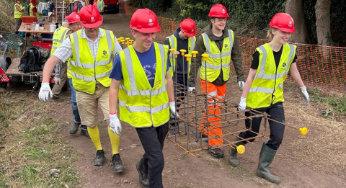
damit, dass jeder sich ein Belegtes Brot oder einen Salat als Mittagessen in eine Brotdose verpackte, die dann mit der Milch für die Teepause in die Kühltruhen verstaut wurde. Der Arbeitstag war dann damit gefüllt das wir mehr von den Stahlbewährungen zusammengebaut haben, wobei einige neue Personen nun diser Aufgabe zugeteilt worden waren, da sie ihr Ursprüngliche aufgabe schon am Vortag soweit beendet hatten. Die ersten Schächte für die Bewährungen wurden zu ende ausgehoben und der erste Käfig sogar schon in Position gebracht.
Abends ging es dann nach einem Schnellen Abendessen mit Kajaks oder dem ein oder anderem Kanu auf den Kanal, wobei dann auch der ein oder ander ziemlich gut druchnässt wurde. Jonathan G. ist beim Einsteigen in sein Kajak auch direkt als erster komplett untergegangen, da er aber seine Dose Bier retten konnte war laut ihm alles Prima und er ist dann fröhlich erneut ins Boot gestiegen. Etwas anders sah es dann bei Bernd aus der sich nach einem kompkett mit Wasser gefülltem Boot sich dazu entschied das Boot wieder an die Unterkunft zu ziehen und die anderen weiterfahren zu lassen. Nachdem dann endlich alle zurück waren wurden alle Boote wieder verstaut und alle sind erstmal ein zweites mal an dem Tag duschen gegangen.
.
Dienstag führ der erste Van schon um 7 Uhr morgens los, da an diesem Tag die erste Ladung Beton erwartet wurde und es noch einiges vorzubereiten gab. Unter anderem mussten nämlich noch die nächsten Stahlbewährungen fertig gebaut und in die noch auszugrabenden Schächte gelegt werden, als auch die Verschalung zur Formung des Betongusses andgebracht und angepasst werden. Dies alles musste bis 13:00 Uhr geschafft sein. Etwas hektisch wurde es dann doch noch als die Btonlieferung schon um 12:30 eintraf; also eine halbe Stunde eher als erwartet. Zum glück konnten die örtlichen Voluntäre einen Teil des Betons schonmal für die Basis ihrer Füßgängerhebebrücke gebrauchen, sodass wir ein paar extra Minuten hatte um unseren Teil bestmöglichst vorzubereiten. Eine Gruppe ist dann auch eine halbe Stunde eher als dei anderen zurück zur unterkunft gefahren, waährend die zurückgelassenen noch die restlichen Werkzeuge verstaut haben. Durch die zeitliche Trennung war es dann aber für die Männer einfacher zu Duschen, da der Andrang ein wenig verteilter war.
Der nächste Tag (Mittwoch) verlief dann ähnlich wie die Tage zuvor damit, dass weitere Stahlvertsrebungen gebaut wurden, Gruben für die fertigen Stahlbewährungen ausgehoben und das Kanalbett Tiefergelegt wurden. Außerdem wurde an den bereits in Beton eingegossensn Stellen nun die Stahlbewährung für die Wände anmontiert. Dies war dann
aber dank der vorausgehenden Übung an den anderen Stahlverstrehbungen relativ leichte Arbeit die sich auch recht schnell erledigen ließ. Zum Abschluss des Arbeittages mussten wir dann noch die Stützen für die Verschalung besagter Wände noch von deren Anleiferungspunkt vom Vortag in den abgesperrten Compound tragen, welches dann in einer großen Aktion nach den Prinzip von “jede Hand am Deck” sehr schnell erledigt wurde. Trozt der nunndoch schon iemlich großen allgemeinen Erschöpfung ging es dann Abends für einige noch zu gemütlichen Bowls spielen. Dieses Spiel sieht viel einfacher aus als es ist und nicht nur ein Ball viel vom Spielfeld in die Grube am Rand.
Donnerstag verlief dann mit einigen neuen Arbeitschritten grundsätzlich sehr ähnlich wie die Tage zuvor. Es wurden neue Schächte für die Stahlbewährungen ausgehoben, sowie die vertikalen Verschalungen für die nächsten Betongüsse angebracht. Dies war nur dadurch möglich, dass die vertikalen Stahlbewärungen zuerst zu ende gebaut Wurden. Des weiteren könnten die ersten Verschalungen von den bereit gegossenen Betonböden entfernt werden und an des neu eingelegten Käfigen neu befestigt werden, da man durch das Wiederverwenden solcher Materialien natürlich eine gewisse Form der Nachhaltigkeit fördert. Außerdem war die Motivation neue Holzverschalungen aus dem zwischenlager bis ganz zu den Gruben zu tragen nicht so super massiv hoch. An diesem Tag mussten wir dann auch sehr Pünktlich von der Arbeitsstelle loskommen, da wir nach dem Abendessen noch einen Termin hatten. Aufgrund dieses Termins gab es Abends Fischbrötchen mit ein paar gesunden Beilagen sowie ganz vielen schnellen Duschen. Sobald alle Frauen geduscht hatten wurde es sogar dem ein oder anderen Mann gestattet die Damenduschen zu verwenden (natürlich erst nachdem alle Frauen diesbezüglich informiert worden waren!). Anschließend führen wir mit den Vans zum Bogenschießen. Die Sieger beim Bogenschießen waren Jack und Tina, die in Ihren jeweilgen Geschlechtern die höchsten Ergebnisse erschossen hatten. Auf dem Weg zurück zur Unterkunft wurde entschlossen, dass wir noch auf ein oder zwei Pints ein lokal aufgesucht werden sollte. Als wir ankamen und aus den Fahrzeugen ausstiegen kam uns der Besitzer des Lokals schon entgegn, da er eigentlich dabei gewesen war, das Lokal für en Abend zu schließen. Aufgrund dessen, dass wir aber eine relativ große Gruppe waren hat er trozt unseres Protests nochmal für uns aufgemacht. Wir blieben dann etwas unter einer Stunde dort, da wir erfuhren, dass es auch noch der Hoochzeitstag des Besitzers war und seine Frau eigentlich mit dem Essen zuhause auf ihn wartete. Somit fand auch der Donnerstag sein schönes Ende.
Malcolm Parker
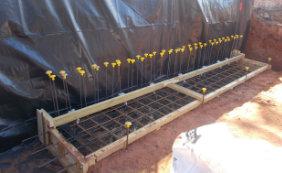
Am letzten vollen Arbeitstag (Freitag) unserer Woche ging es dann nochmal richtig zur Sache, denn um Zehn Uhr sollte die nächste Betonladung geliefert werden. Das hieß für alle Mann erstmal das die bereits eingestzten Stahlverstrebungskäfige noch zu ende Verbunden und verschalt werden mussten und auch noch einge anderen Vorbereitungen getroffen werden mussten. Als Dann der Betonlaster da war hieß es für einige Männer “ran an die Schubkarren!”, denn an die hinterste Wand kam man weder mit lader noch mit dem Digger The reinforcement and shuttering are set up ready for the base concrete pour

ran um sie zu befüllen. Der Beton musste also den letzten Teil der Strecke immer in Schubkarren befördert und dann auch durch diese in die vertikale Verschalung eingegossen werden. An der zweiten Wand war es dann etwas einfacher, da der Dumoeper und Digger beide gerade so nah genug an die Wand kamen um sie ohne viel manuelle Arbeitkraft zu befüllen. Nachdem dann der ganze Beton seine Verwendung gefunden hatte ging es auch schn daran aufzuräumen und vor allem auch die Werkzeuge zu reinigen, da alles schön ordentlich für die Freiwilligen der nächsten Campwoche hinterlassen werden sollte. Das Aufräumen war dannauch der letzte Arbeitschritt der tatsächlichen Arbeitswoche auf dem Gelände. Wir sind dann alle am frühen Nachmittag wieder zurück zur Unterkunft gekommen, wo wir als nächstes die Vans wieder sauber gamacht haben. Diese Reinigung beinhaltete sogar da Waschen von außen mit einem Hochdruckreiniger, der dann von mehrern Leuten sogar ausprobiert werden durfte. Nachdem all dies dann getan war, wurden einige Spielstationen aufgebaut an der jeder sein Glück versuchen konnte. Beer o’clock wurde dann auch sehr früh ausgerufen und jeder hat die freie Zeit genossen. Zum letzten Abendessen gab es dann Hamburger frisch vom Grill und als Nachspeise dann Eaton mess und Kugeln Eis. Drei der Spiele wurden dann sogar ausgewertet und die Gewinner in der letzten gemeinsammen Abendrunde verkündet. Beim Entenangeln gewann Adrew mit einer Punktzahl von -8 und erhielt als Preis einen kleinen Teddy, beim Plattenrollen gewann Jonathan P. mit einer Punktzahl von 44 die besagte Schallplatte und beim Würfelweitwerfen oder -schießen gewann Nina dann den goldenen Stiefel. Außerdem erhielt jeder Teilnehmer einen Schlüsselanhänger mit den Campdaten sowie eine Teilnahmeurkunde. Der Abend lief dann in die letzte Nacht über in der es dann praktisch schon ein Wettschnarchen in der Schlafhalle gab als die letzten sich in ihre Betten legten.
Am Samstag ging es dann nur noch darum seinen eigenen Kram zusammenzulesen, einzupacken und bestenfalls in sein Auto einzupacken. Auch wurden die Räume noch gesaugt und die Badezimmer allesamt gereinigt, da am Anchmittag ja schon die Teilnehmer für die nächste Campwoche einziehen würden. Gegen halb zehn Uhr morgens waren dann auch schon die meisten auf ihrem Weg nach Hause. Ginger der sogar noch etwas früher losgefahren war, schlief dann auf der Hochzeit ein zu der er geeilt war und vergaß sogar seine Jacke, die aber erst am nächsten Samstag endeckt werden würde.
Nina and Emma Schimansky
Switching back to English for the second week, Malcolm describes channel construction, archery, fish finger sandwiches and more…
Lichfield Canal Camp Report
Week 2: 2 - 9 August at Gallows Wharf
This is a personal (and possibly idiosyncratic) view of Week 2 at Lichfield.
Social: We had 19 campers, including three doing it as part of their Duke of Edinburgh’s Award, from as far apart as Yorkshire, Kent, Devon and Wales and several places in between. Colin and Evvo warmly welcomed Andy, Daniel, Dylan, Janice, Malcolm, Matt, Nigel, Nina, Pete, Rae, Rex, Rob, Sue, Tina, Tracey and Will, not forgetting Matthew, our ‘resident’ cook, who was living on his narrowboat on the Coventry Canal, 200 yards away.
On the Saturday we went on a trip to see the work site, which was Gallows Wharf in Lichfield. This was followed by the famous Oscar-winning WRG video on health and safety. Finding where to sit for Dinner was interesting, as we each had a vintage LP record, and the plastic sleeve enclosed a round logo of a red WRG hard hat bearing our name. It made for a good icebreaker. To add to the confusion, before dinnertime each day these were shuffled around the tables and the clockface was ‘amended’.
Entertainment included listening to Test Match Special while working on the Sunday (England lost by six runs).
After Dinner on Sunday we had the pleasure of listening to Colin reading extracts from the Practical Restoration Handbook; did you know that in the section covering COSHH there are sections on plasterboard and rockwool (both of which are used extensively in canal restoration(!)), while working with Rebar (reinforcing bars for concrete) only has one page? Under Formwork we learnt that “you may wish to get out your junior carpentry kit”.
On the Monday evening there was the opportunity to go canoeing on the adjacent canal; unfortunately, due to some over-enthusiastic launching, some participants got rather wet.
On Tuesday we came
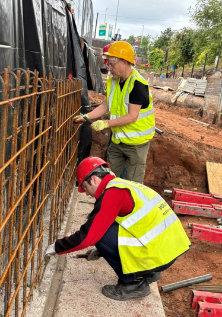
back from site via Darnford Moors, which WRG worked on two years ago. Wednesday’s activity was Indoor Bowls and our thanks must go to the members of the Tamworth Indoor Bowls Club who made us exceedingly welcome. The same can be said for the members of the Mercia Archers on Thursday, who taught us much, in good spirit, and the star archers were Tina, Rae and Will.
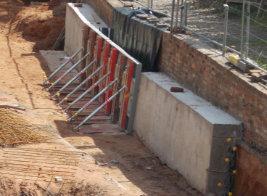
On Friday it was all very different as we helped Rob to celebrate his 21st Birthday a day early. We started with a barbecue prepared by Evvo and played silly games outdoors, including target shooting with water pistols, a coconut shy, throwing a large foam dice to see who could throw it the furthest (well done Matt) and there was the added benefit of ice creams and a candyfloss machine. We presented Rob with a Birthday cake, his very own red hard hat and a toy digger.
Meals - I forgot to make a note of all the lovely meals, which included Lasagne, Roast Pork and trimmings, Chicken Fricassee, Pork in Cider, Giant Fish Finger Sandwiches and Salad; Fruit Crumble, Eton Mess, Bread & Butter Pudding and Lemon Cheesecake. We were on site around 8.00 am to complete preparations for the arrival of the concrete, so Matthew brought us hot sandwiches, pasties etc at 9.30 am. Thank you, Matthew, for the 50 hours spent in shopping, preparing and cooking our lovely meals.
The Work: This was continuing the channel construction along the section of canal between Tamworth Road and Gallows Wharf in Lichfield, including placing a concrete base to keep the channel watertight and excavation of the channel to final depth.
We followed Week 1, who had done much preparatory work, and we had the benefit of their experience in developing a ‘production line’ for the construction of the rebar frames and the setting up of the shuttering for the concrete base.
I thought it would be helpful to describe the whole process in its various stages from start to finish.
The rebar came in two forms – a mesh 5 metres x 2 metres and single bars in various straight lengths, ‘J’ and ‘L’ shapes and a larger ‘double J’ (i.e. a straight with a ‘U’ at each end).
(1) The mesh was cut into the required size (normally 2.5 metres x 1 metre) using a powered shearing tool. This had the advantage of not creating lots of sparks by using an angle-grinder.
(2) The base of the reinforcement was created by adding to the 2.5m x 1m mesh the ‘double J’s at 20 cm intervals. On top of this was placed a further 2.5m x 1m mesh to create the ‘cage’. Then the ‘L’s were added to the cage to create uprights. At each intersection ties were fastened using a puller; each cage took 192 ties. In view of the weight involved it took six people to carry each cage down to its final destination. Two 2.5m cages were placed in each 5m bay. Plastic sheeting was placed
under and behind the cages in preparation for delivery of the concrete.
(3) Concrete was delivered and put into a 6-ton dumper and carried to the work site where it was taken from the dumper and placed into the cage by an excavator. There is an exquisite pleasure in watching someone operating machinery so smoothly and making it look so easy. A vibrator was used to settle the concrete before it was smoothed off.
(4) A back mesh with ‘J’s facing forward was placed against the plastic and a further mesh attached to the ‘J’s and the front ‘L’s using many more ties.
(5) Shuttering supported by metal stays and wooden formwork was then erected on this concrete base in preparation for the delivery of the concrete for the wall.
(6) Once the concrete in the wall had ‘gone off’ the shuttering was removed to provide a completed 5 metre section of wall.
We had three deliveries of concrete during the week, but the firm were unable to deliver the one due on the Friday. We have calculated that we have given approximately 1,000 person-hours during the week, have pulled over 4,500 ties in the rebars and created 30 metres of new concrete rather than the 40 metres envisaged.
We had generally good working weather but had rain early in the week and a had a very hot day on the Friday for packing up.
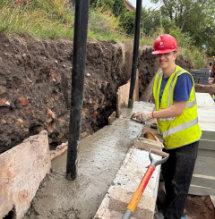
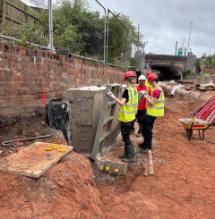
Various officials of the Lichfield & Hatherton Canals Restoration Trust came to express their appreciation of the work we were doing while Mick and another Pete joined us as ‘freelancers’ on site for three days.
Our thanks go to Colin (supported by Tina) and Evvo for all their hard work in the preparation for the camp and their continued support, enthusiasm and encouragement throughout the week.
Malcolm Parker
Alex Melson concludes his four-part vision for a nature-friendly restored canal network with his list of the top ten ways to achieve it…
Waterway restoration hasn’t always had the easiest of relationships with nature conservation. Sometimes as canal restorers wanting to reopen waterways for boating (and other compatible uses), we have found ourselves at loggerheads with wildlife interests who may see reopening to navigation (particularly by powered craft) as a threat to an important ecological asset. But that needn’t be the case. Depending on the methods used, restoration can actually benefit biodiversity at the same time as extending the navigable waterways network - and this can be used to gain wider support for canal reopening.
Alex Melson (who many of you may recall from his time as one of the IWA Head Office staff with responsibility for WRG matters - before moving on to pursue a career in nature and the environment) has returned as a volunteer contributor of a series of articles about wildlife and inland waterways.
In the first one, he explained why wildlife interests regard the waterways network as so important to biodiversity and nature conservation. In part two he went on to show how waterway restoration can be done in ways that contribute to the wildlife value of canals. His third piece went a step further and brought us his vision for a waterway network of the future where boating goes hand-in-hand with nature and communities. Finally this time he gives us his list of ten ways to achieve this goal…
Canals, once vital to trade and transportation, now serve as ecological corridors that support a range of wildlife. In recent years, the restoration of these historic waterways has become a priority for conservationists, as they offer an opportunity to improve biodiversity while preserving cultural heritage. When restoring canals, it’s crucial to implement strategies that enhance their role as habitats for wildlife. Below are the top 10 methods to enhance canals for wildlife during restoration projects.
Many canals have been modified to accommodate human activity, which often results in a loss of natural flow patterns. During restoration, reintroducing more natural water dynamics—such as variable flow rates, meanders, and seasonal fluctuations—can create a healthier environment for aquatic species. Natural flow patterns encourage the development of diverse habitats like wetlands, riffles, and pools, which support a range of fish, amphibians, and invertebrates.

Installing fish passages: one of the ‘Unlock the Severn’ fish-passes
Water quality is a fundamental factor in supporting wildlife populations. Restoring riparian vegetation, reducing nutrient pollution from surrounding agriculture, and introducing sediment management techniques can all improve water clarity and oxygen levels. Better water quality benefits not only fish and aquatic plants but also species that rely on healthy waterways for drinking, breeding, and shelter.
Wetlands along canals serve as critical habitats for wildlife such as birds, amphibians, and invertebrates. By reestablishing natural wetlands and floodplains during canal restoration, planners can increase the availability of breeding sites, food sources, and shelter for many species. Restored wetlands also play an essential role in filtering water and providing flood mitigation.
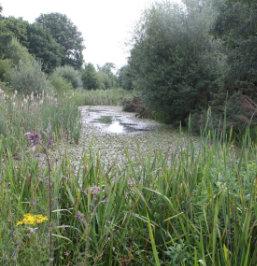
Fish migration is often hindered by locks, weirs, and other artificial structures along canals. Installing fish passages, such as fish ladders or bypass channels, allows fish to move freely between different parts of the canal. This helps support fish populations, especially species that require access to different habitats at different stages of their life cycle, such as salmon and eels.
In areas where natural habitats are scarce, artificial structures can help provide shelter and breeding grounds for wildlife. Installing bat boxes, bird nesting sites, and artificial reefs can encourage the presence of species such as bats, waterfowl, and fish. These structures can be tailored to the specific needs of local wildlife, offering them safe havens along the restored canal.
Riparian vegetation—the plants growing along the banks of canals—serves as a crucial habitat for a variety of species. During restoration, efforts should be made to plant native trees, shrubs, and grasses along the canal’s edge. These plants not only stabilize the banks and reduce erosion but also provide food, shelter, and nesting sites for birds, mammals, and insects.
Invasive species can disrupt local ecosystems, outcompeting native plants and animals. During canal restoration, controlling or removing invasive species is essential to help native wildlife thrive. This may involve manually removing non-native plants, introducing natural predators, or enhancing conditions that favour native species. Effective invasive species management ensures that restored canals are beneficial for native biodiversity.
Canals can serve as vital wildlife corridors, connecting fragmented habitats. When restoring canals, it’s important to consider how the canal fits into the broader landscape. Creating or enhancing connections to nearby woodlands, meadows, or wetlands can help species move safely between different habitats. Installing underpasses or overpasses for terrestrial wildlife, such as amphibians or small mammals, can also reduce the risk of roadkill and promote safe migration routes.
Sediment build-up in canals can degrade water quality and harm aquatic life. During restoration, careful management of sediment levels is essential to maintain healthy aquatic ecosystems. This may include dredging to remove excess sediment, followed by strategies like planting aquatic vegetation to prevent erosion and promote a balanced sediment regime. Healthy sediment management promotes clearer water and more suitable conditions for aquatic species.
Community involvement in canal restoration projects can help ensure the long-term success of wildlife enhancements. Local communities can participate in monitoring wildlife, planting vegetation, and keeping waterways clean. By fostering a sense of ownership and stewardship, these efforts can create lasting ecological improvements and ensure that the restored canal continues to thrive as a wildlife haven.
Conclusion
The restoration of canals is a unique opportunity to boost biodiversity and create valuable habitats for a wide range of species. By implementing these 10 methods—ranging from improving water quality to controlling invasive species—restoration projects can transform canals into thriving ecosystems that support both wildlife and human communities. As we continue to restore and rehabilitate these waterways, we can ensure that canals remain not just a legacy of the past but also a vital part of a sustainable and biodiverse future.
Alex Melson Martin Ludgate
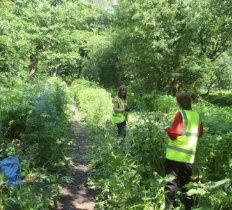
Invasive species: London WRG balsam-bashing on the Uttoxeter
On East Anglia’s River Stour, the River Stour Trust are celebrating the reopening of Dedham Lock, awaiting new gates since 2016
Dedham Lock, one of four restored locks on the East Anglian River Stour, has been reopened again following fitting of new gates.
The lock, on a section of the river on the Essex and Suffolk border which was made famous by the paintings of John Constable, was officially declared open by River Stour Trust vice president and well-known TV personality Griff Rhys Jones.
A £110,000 funding package with contributions from Enovert Community Trust, the Garfield Westin Trust, the Pilgrim Trust, Essex Heritage Trust and Dedham Parish Council, plus £40,000 raised by volunteers and 15,000 volunteer hours of work, enabled the work to go ahead. At the opening, the Mayor of Colchester said “A lot of money went into the project, and the Trust and volunteers have done a great job.”
This part of the lower reaches of the river also includes Flatford Lock (which features ‘lintels’ across the ends of the chamber, an unusual feature of River Stour locks), originally restored in the 1970s, regated in 1992 and again in 2014; and Stratford St Mary Lock, reopened in 2018. In addition, near the far (upstream) end of the

Originally restored and reopened in the 1990s with gates and gear replicating the original design, the lock became unusable in 2016 as the gates were life-expired. It has taken until now to negotiate, plan, fund and carry out the replacement.
navigation near Sudbury, a new Great Cornard Lock was built and opened in 1997. Ultimately the Trust’s aim is to reinstate all 13 original locks to enable through navigation from end to end.
SUCS volunteers close the gap in the current length of canal and towpath under reconstruction, and prepare to move on southward…
It’s gone. The gap in the towpath is no more. R.I.P.
“July was marked by two extra work party days thanks to large numbers of corporate volunteers from Colas Rail during the week following the regular work party”. Said Tom Fulda, Shropshire Union Canal Society restoration project manager, reporting progress on SUCS volunteers’ ‘Crickheath South’ project to rebuild the Montgomery Canal channel southwards from the limit of navigation (since 2023) at Crickheath Wharf to the new Schoolhouse Bridge and beyond. “An enormous amount was achieved over these five days”. Work sweltered on four out of the five days (incorporating the country’s third heatwave of the year). However, torrential rain overnight on Saturday complicated matters and slowed progress on Sunday morning. Volunteers consoled themselves with the knowledge they hadn’t come here to remain clean.
The main event was completing the current work area – lining and blocking (to make the notoriously leaky canal watertight when restored, the bed is being lined with a waterproof lining material, which is then protected by a layer of concrete blocks) the remaining gap in the channel and closing the gap in the towpath which has provided our point of access to the work area. Lining a straight channel of regular dimensions and working in a single direction is straightforward. As highlighted in previous reports, the current site was none of the above. The channel here widens considerably on a bend and it was necessary to work from both ends of the site towards the access/exit point.
The work area was complicated further by the requirement for a ‘soft


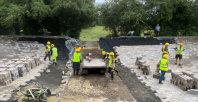
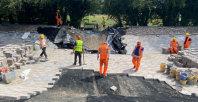
Various stages of closing the gap
bank’ (requiring considerable volumes of soil to be placed behind the hollow blocks) without having a haul road to provide access for plant. The answer to this conundrum was to drive a mini digger up to the top of the offside bank but this was only possible to do safely on bare earth so a gap in the liner had to be left for the digger to exit through the towpath gap once finished. The liner system, incorporating 4 layers of different products which inconveniently come in different widths, was folded back to varying degrees on both sides to expose bare earth, then folded back again once the digger had exited. Of course, being on a bend means the outside of the bend (offside bank) is longer than the inside (towpath) so various pieces of the different liners had to be cut to unusual sizes to cover any gaps with sufficient overlap. If that was not complicated enough a cut line in the channel blocks at a constant level was required on the offside in order to accommodate hollow blocks used to retain soil for the soft bank.

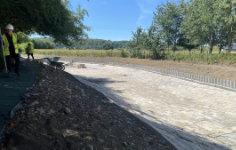
The end result looks effortlessly graceful. However hard you look you will not see the ‘join’, an incredible achievement given that each block is half a metre long, they were laid from each end meeting in the middle and the course had to incorporate a broad bend rather than a straight line. The final step was to close the gap in the towpath by building up the bank to full height. First, a sufficient quantity of blocks was stored in the channel bed before the access was eliminated.
As the channel works complete, the towpath is no longer required to provide access for some construction tasks and a final wear course of grit can be applied to produce the finished product. In total, 230 metres of previously constructed towpath was treated in this way.
Beside the channel and towpath work there was a whole host of activity relating to the next section of channel to be reconstructed. In August the works compound was due to relocate further down the channel to Schoolhouse Bridge. Site preparation continued apace, and the compound now has a perimeter fence installed all the way round thanks to the volunteers from Colas Rail. Remaining stock of some materials was transported from the current compound to the new. Work continued to kit out the welfare cabin – a luxurious establishment compared to the current facility.
Substantial vegetation clearance was undertaken northward from the new compound back towards the current site. The new compound will be used for works both north and south of the bridge, and time was also spent carefully reducing the level of temporary backfill beneath the bridge. This will allow larger plant to access the area through the bridge southwards.
The Wooden Canal Boat Society struggle with silt, take advantage of the enforced lack of boating this year, and appeal for volunteers
At the beginning of 2025 our motor narrow boat Southam was slipped at the Ashton Packet Boat Co slipway for her stern end to be strengthened with steel plates. This will keep her going for probably 10 years before a stern end rebuild is necessary. A replacement engine was lifted in, similar to the BMC Commodore that had powered her since 1965. After launch, work began on rejuvenating the now dilapidated cabin conversion. A Go Fund Me appeal has raised £835 so far. Contributions welcome: here’s a link https://gofund.me/9f6c11ab
From March, attention turned to improvements to unpowered butty boat Hazel. These include replacing her 10 year old battery bank with LiFePO4 batteries, an internal repaint and extending the central heating system. Kira Hardy paid a visit to repaint the name on the top bends at the stern. In past years springtime work on Hazel has been curtailed, incomplete, because of a need to get her out to festivals at Middlewich and Lymm. This year the breaches on the Bridgewater and Macclesfield canals cancelled any thoughts of going anywhere, so our volunteers can take their time to get the jobs done to their own satisfaction before she returns to wellbeing trips. These will be strictly local as most of the locks are shut for lack of water. Volunteers will be needed for crewing trips, mostly between Ashton and Marple.
Forget me Not has been immobile since what turned out to be a disastrous trip up the Huddersfield Narrow Canal in October last year. The
idea was to take some guests on a wellbeing trip from Ashton, up the very narrow canal to Mossley, spend the night there, then wind at Waggon Road and return to Ashton. The guests would stay on Hazel, and Forget me Not would tow her. We’d done such a trip before, though not since the pandemic.
The winding hole at Waggon Road turned out to be so silted that it probably wouldn’t allow a 50ft boat to wind, let alone a full length 70ft one. No problem, we thought, just go on to Roaches Lock where we’ve winded before in the wide.
Same story! Continued silting has made winding impossible for full length boats. The next winding hole is at Well-i-Hole Road, up several more locks. We tied for the night near the Royal George aqueduct, then carried on to Well-i-Hole and tried to wind in the morning.
There’s a stream runs into that winding hole which, inevitably, brings silt. Nevertheless, lots of volunteers showed up to help and, with much brute force and ingenuity, the boats were eventually turned round.
We wrote to the Canal & River Trust regarding the silting of winding holes. As
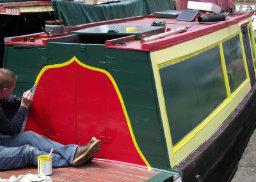
anticipated, the reply was sympathetic but not encouraging, citing their difficult financial situation and the need to target resources where most effective.
Both the Huddersfield Narrow Canal and the Rochdale Canal were restored after decades of hard work and lobbying by volunteers. Both are caught in a vicious circle. They’re both hard work (but worth it) because of the frequency of locks, and have water supply issues. This means that boat passages are less than most waterways. As a result, CRT are less willing to spend money on maintenance compared to busier canals. Lack of maintenance makes them harder to use, and so boat passages reduce further.
On the return trip it became clear that Forget me Not’s gearbox was not happy. At lock 9 it failed completely.
The next day Hazel was bowhauled to her home at Portland Basin and Forget me Not was shafted as far as Knowl St Heritage Boatyard for her gearbox to be removed for repairs. This would have been straightforward but for the usual parts supplier in Sweden having run out of the relevant components.
Efforts to find other suppliers inevitably led back to the same source in Sweden. Eventually we found someone who could repair the worn parts and the gearbox was re-assembled and installed. A trip to Stalybridge and back was run to collect some brash from last year’s hedge trimming. This is going to be turned into biochar, but that’s another story.
Shortly afterwards the engine expired whilst running to top up the batteries. It’s a serious problem, so she’ll be out of commission for a while. Meanwhile, Tony Ellams has been busy making improvements
to the cabin so, at least she looks better and the decline in appearance that had set in, post Covid, has been reversed.
The lack of a viable motor boat would be a problem, but for the arrival in the area of Benevolence. This wooden motor boat was built by Nursers of Braunston in 1938 for John Green of Macclesfield. She was bought in Oxford last year by our member Joe Hodgson. Joe is a tree surgeon from Cumbria who supplied some of the oak for restoring Hazel. This inspired him to start moving partially on to the canal. He is allowing us to borrow Benevolence for towing.
Shortage of volunteers has caused several charity shops in Ashton to close down. Ours has kept going, though it has been difficult to staff it at times. It remains the main income generator to support the wooden boats. The shop volunteers do an amazing job and it’s not only the biggest charity shop in Ashton but prices items at a level that local people can afford.
In the last few years we’ve seen the number of surviving wooden boats declining as owners give up on them because of the onerous challenges of maintenance. It’s been frustrating not to be able to intervene and help, but we have enough on with the existing fleet. It’s really important to keep this aspect of the canals alive and active. There are no wooden narrow boats anywhere else in the world!
Anyone who would like to help with the WCBS work, please get in touch. We particularly need volunteers who can take charge of some aspect of the work, be it looking after a particular boat, organising events or publicity, developing online sales etc etc. See the full list below.
• Online salespersons
• Boatyard development worker
• General progress chaser
• Training organiser
• Safety organiser
• Boating crew organiser
• Trainee skippers
• Recycling organiser
• Local fundraising organiser
• Tools organiser
• Materials organiser
• Electrician
• Hazel house/boatkeeper
• Hazel bookings person
• Hazel outreach worker
• Maintenance person for each boat.
• Online promotions coordinator.
• Publicity officer.
• Boat presentation person (brass polisher)
Many hands makes light work! If you would like to help, get in touch.
Wooden Canal Boat Society, Charity Shop, 173 Stamford St Central, Ashton under Lyne OL6 7PS
The WRG camp, from July 26, 2025, toAugust 2, 2025, was the first of two weeks at the Lichfield site.
On Saturday, all participants were required to arrive at the accommodation by 2:00 PM at the latest to then inspect the work site. Those who arrived early had to unload the trailer, check the inventory, and pack everything back into the trailer and vans. During this time, at least one new nickname was also given.
Because several people were running late, we didn't actually set off in the two nine-seater vans until around 2:30 PM to inspect our site for the first time. On the way, we met the last straggler, who decided to drive to the accommodation and not visit the site for the first time until the following day. After we were shown the worksite, we returned to our accommodation, where we received a safety briefing, which focused primarily on what protective equipment we should wear at all times and reminding each other to behave safely and properly, because only a tidy workplace is a safe workplace.
After all the safety briefings were finally completed, we had some free time before dinner. During this time, some set up their sleeping quarters while others gathered their personal protective equipment. There was quite a bit of conversation at dinner, including a discussion about why Jack is now nicknamed Ginger (he was wearing an orange T-shirt).After dinner, it was up to each individual whether they wanted to go to bed or stay in the common room for conversations and games.As soon as the first group went to their dormitory, those in the common room were told to be much quieter so the others could sleep.
On Sunday, after a good breakfast together, we headed out to the site quite early, where we first unloaded the vans and stowed the tools in the designated containers.Afterwards, everyone was gradually assigned various tasks, including cutting rebar (reinforcing bar for the concrete), learning how to assemble a rebar cage, and digging the work pits at the other end of the work site. It took us until lunch break to assemble the first cage, as it wasn't easy to get into the swing of things at first. During the rest of the workday, we completed a total of three cages to the point where they could be relocated the next day.
When we returned to the accommodation after work, everyone rushed to the showers, although the shower-to-person ratio was quite tricky. There were two showers for the four women and only two for the 14 men, as one of the showers was broken.After everyone had showered, however, we had a basic version of a typical Sunday meal and enjoyed the evening together.
Monday began, like every subsequent day, with a communal breakfast. Everyone packed a sandwich or salad for lunch in a lunchbox, which was then stored in the freezer along with milk for tea break. The workday was then filled with assembling more of the steel reinforcement, with a few new people being assigned this task, as they had already largely completed their original task the day before. The first shafts for the reinforcements were finally dug, and the first cage had even been put into position.
In the evening, after a quick dinner, we headed out onto the canal in kayaks or the occasional canoe, where a few people got pretty soaked. Jonathan G. was the first to sink completely while getting into his kayak, but since he managed to save his can of beer, he said everything was fine and happily climbed back into the boat. Things were a little different for Bernd.After his boat was completely filled with water, he decided to pull the boat back to his accommodation and let the others continue on. Once everyone was finally back, all the boats were stowed away again, and everyone went for a second shower that day.
On Tuesday, the first van left at 7 a.m., as the first load of concrete was expected that day, and there was still a lot to prepare.Among other things, the next steel reinforcements had to be completed and placed in the shafts that still needed to be excavated, and the formwork for the concrete pour had to be installed and adjusted.All of this had to be done by 1 p.m. Things got a little hectic when the concrete delivery arrived at 12:30 p.m., half an hour earlier than expected. Luckily, the local volunteers were able to use some of the concrete for the base of their pedestrian lift bridge, giving us
a few extra minutes to prepare our part as best as possible. One group then drove back to the accommodation half an hour earlier than the others, while those left behind stowed the remaining tools. The split in time made it easier for the men to shower, as the crowds were a bit more spread out.
The next day (Wednesday) was similar to the days before, with more steel bracing being built, pits being dug for the finished steel reinforcements, and the canal bed being lowered. In addition, the steel reinforcement for the walls was installed in the places where concrete had already been cast. However, thanks to the previous practice on the other steel bracings, this was relatively easy work and could be completed quite quickly.At the end of the day, we then had to carry the supports for the formwork of the walls from their attachment point from the previous day into the cordoned-off compound. This was then accomplished very quickly in one major operation according to the "every hand on deck" principle. Despite the by now considerable general exhaustion, some of us went for a leisurely game of bowls in the evening. This game looks much easier than it is, and more than one ball fell from the playing field into the pit at the edge.
Thursday was essentially similar to the previous days, with a few new work steps. New shafts were excavated for the steel reinforcements, and the vertical formwork for the next concrete pours was installed. This was only possible because the vertical steel reinforcements were completed first. Furthermore, the first formwork could be removed from the already poured concrete floors and reattached to the newly inserted cages, as reusing such materials naturally promotes a certain form of sustainability. Moreover, the motivation to carry new wooden formwork from the interim storage area all the way to the pits wasn't that great. That day, we had to leave work very punctually, as we had an appointment after dinner. Because of this appointment, we had fish sandwiches with some healthy side dishes in the evening, along with lots of quick showers.As soon as all the women had showered, one or two men were even allowed to use the women's showers (of course, only after all the women had been informed!).Afterwards, we drove in the vans to the archery range. The winners of the archery competition were Jack and Tina, who had the highest scores for their respective genders. On the way back to the accommodation, it was decided that we should visit a local for a pint or two.As we arrived and got out of the vehicles, the owner of the pub approached us, as he had actually been closing the place for the evening. However, because we were a relatively large group, he opened the bar for us again despite our protests. We ended up staying there for just under an hour because we learned that it was also the owner's wedding day and his wife was actually waiting for him at home with dinner. So Thursday came to a happy end.
On the last full working day of our week (Friday), things really got going again, as the next load of concrete was due to be delivered at 10 o'clock. This meant that the steel bracing cages that had already been installed still had to be connected and shuttered, and a few other preparations also had to be made. When the concrete truck arrived, some of the men had to get to the wheelbarrows, because neither the loader nor the digger could reach the farthest wall to fill it. The concrete had to be transported the last part of the way in wheelbarrows and then poured into the vertical formwork through these wheelbarrows. The second wall was a bit easier, as the dumper and digger both got just close enough to the wall to fill it without much manual labor. Once all the concrete had been used, it was time to tidy up and, above all, clean the tools, as everything had to be left neat and tidy for the volunteers for the next week's camp. Cleaning up was the last step of the actual work week on site. We all returned to our accommodation in the early afternoon, where we next cleaned the vans. This cleaning even included washing the outside with a pressure washer, which several people were even allowed to try out.After all that was done, a few game stations were set up where everyone could try their luck. Beer o'clock was then announced very early, and everyone enjoyed the free time. For the last dinner, there were hamburgers fresh from the grill, and for dessert, Eaton mess and scoops of ice cream. Three of the games were even evaluated, and the winners were announced during the last evening gathering.Adrew won the duck fishing game with a score of -8 and received a small teddy bear as a prize. Jonathan P. won the record rolling game with a score of 44, and Nina won the golden boot for the dice throwing or shooting competition. Each participant also received a keychain with their camp details and a certificate of participation. The evening then turned into the last night, when there was practically a snoring competition in the dormitory as the last people went to bed.
On Saturday, it was all about gathering your own stuff, packing it, and, if possible, packing it into your car. The rooms were also vacuumed and all the bathrooms cleaned, as the participants for the next week of camp would be moving in that afternoon. By 9:30 a.m., most people were already on their way home. Ginger, who had left even earlier, fell asleep at the wedding he had rushed to and even forgot his jacket, which wouldn't be discovered until the following Saturday.
Nina and Emma Schimansky
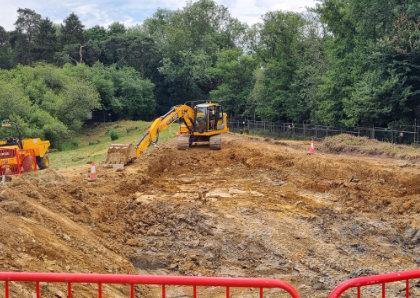
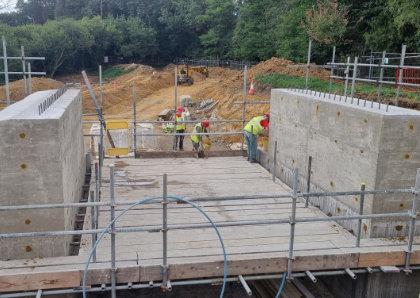
…to this in July
